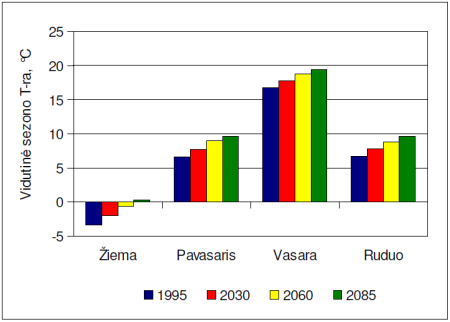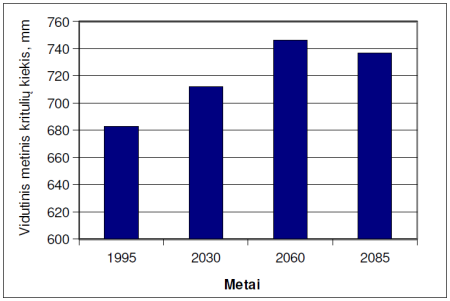More and more people around the world live in cities. Increasing anthropogenic pressures are changing the composition of the Earth’s atmosphere, its land surface and ecological balance. Although population growth in cities and climate change are not superficially linked, urban adaptation to climate extremes is becoming very important as urban populations grow. Taking the necessary adaptation measures in time can save lives and minimise damage to urban infrastructure.
Temperature and precipitation projections for Vilnius are based on the A1B greenhouse gas emissions scenario and the average of three climate model outputs (BCM-RCA, ECHAM5-REMO, HadCM3-HadRM).
Average annual, average minimum and average maximum temperatures in Vilnius are projected to continue rising and at the end of 21st century. will be 3.0-3.2 ºC warmer than 1981-2010 average.
The most pronounced temperature changes will occur during the cold season, with average winter temperatures likely to turn positive by the end of the century (Figure 1).

As temperatures rise, the recurrence of extreme heat and cold will change. By the end of the century, Vilnius will no longer experience severe frosts (temperatures below -25 °C). The probability of severe heatwaves (maximum temperatures above 30 °C for 3 or more consecutive days) increases by 31%.
By the end of 21st century, in Vilnius, severe heat waves can recur on average every 2.5 years (approximately every 7.5 years in 1981-2010). The number of tropical nights (when the minimum temperature does not drop below 20 °C) could increase 13-fold and by the end of 21st century there could be 7 such cases on average. These days, tropical nights are not an annual occurrence in Vilnius.
Changes in precipitation are more difficult to predict, but it is likely that by the end of 21st century average annual precipitation in Vilnius will increase by 50 mm (Figure 2). The number of days with precipitation is forecast to remain stable, but precipitation intensity will increase. Prognozuojama, kad kritulių dienų skaičius išliks stabilus, tačiau kritulių intensyvumas didės. Winter precipitation will increase the most (24%) and, due to rising average temperatures, an increasing proportion of winter precipitation will be wet and rainy.

These projections represent one possible climate change scenario and, depending on future greenhouse gas emissions, changes could be higher or lower.
The increased likelihood of heat waves and tropical nights can lead to higher mortality rates from heart and respiratory diseases, more frequent disruptions to the transport system due to extreme weather events such as rain, heat and snow, as well as to problems with electricity and water supply. During winter, frequent temperature fluctuations of around 0 °C will intensify frost heave and corrosion. But climate change could also open up new opportunities for the city, with rising temperatures extending summer tourism and reducing overall energy costs in winter.